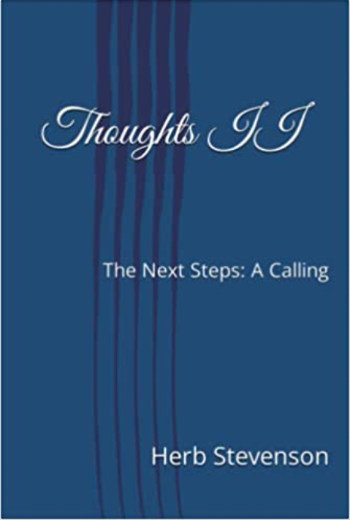

A book by Herb Stevenson, Volume 1. Learn more on Amazon.
Thoughts II:
The Next Step: A Calling

Volume 2 of 3. Learn more on Amazon.
Thoughts III:
Creating The Container

Volume 3 of 3. Learn more on Amazon.
To Lead
Read the article about training with Herb Stevenson in ALN Magazine.
See the article...
Leadership:
The Impact of Internal Competition
Herb Stevenson
April 20, 2016
In the most basic terms, leadership is relational. It requires a group or team of people that are willing to follow. The relationship is based on trust built over time from observed behavior that indicates:
- the leader has the best interest of the employees and organization at heart,
- the leader’s behavior is predictable,
- the leader will act with integrity on behalf of him or her self, the employees, and the organization, and
- the leader is competent by having a clear self awareness of capacity and capability to support work getting done by and through employees—that is the leader has the ability or power to do for the employees what they need done to be successful.
See CCG Newsletter February 2015
The lack of any of these variables will result in a reduced commitment to follow. Work will get done through compliance instead of engagement.
Leadership Qualities
Besides the ongoing observation of trust defining behaviors, leadership, often, has been defined by the qualities that a leader must possess. These have generally been described with respect to team development and task-oriented behaviors. Different times and different situations require different leadership styles; however, certain qualities endure. (Goleman, 2000)These qualities are generally incorporated in the four basic factors (Rittelmeyer 1991):
- Perception of reality: The ability to understand what is happening systematically, to reflect on it, and to incorporate this reality into the contingencies of the environment;
- Team building: The ability to communicate a sense of mission to the group; to recruit the best people and to encourage them in their development; while dealing fairly and humanely with members who are deemed to be deficient;
- Integrity: The maintenance of integrity is fundamental and a character quality necessary for a sense of trust to develop. Fairness must be communicated regularly;
- Management of change: The ability to view change as a universal, yet encompassable opportunity for growth and development.
In more dynamic terms, a successful leader must be able to enter into noncompetitive relationships with individuals who work with him or her and to enjoy vicarious success by providing optimal situations for others to flourish. In other words, the leader must lead, not win.
Competitiveness
A dynamic that has surfaced in my coaching practice is a transference of competing while in lower ranks to positions of authority. By the very nature of most hierarchical organizations, competing shows up in the amount of work that gets done and by whose ideas are accepted toward problem solving . Competition can increase through building sideline support prior to meetings and/or sabotaging the perceived competitors by withholding information, taking credit for work done by others, and silencing contrary (competitive) voices. In each case, the competitiveness of the individual undermines the success of the team or organization. Moreover, it indicates behavior that is not trustworthy nor reflective of effective leadership qualities.
Some leaders will disagree with the prior paragraph, because they believe that competitiveness follows the survival of the fittest thinking. They encourage the competition and feebly contain it by not setting boundaries around what is healthy versus unhealthy competition. Unfortunately, in today’s environment, a “dog-eat-dog” belief misses the point for surviving in today’s capitalistic environment. Such internal competition must include a set of ground rules that reminds everyone that we’re on the same team and undermining others to “win” serves no one but that individual. This becomes more important when we realize that between 1970 and 2010, the life expectancy of corporations has declined from 50+ years to 31.6 years old. (Reeves, et. al., 2016). Furthermore, the rising generation of Millennials do not necessarily compete with fellow employees; rather, they seek employment where team competition towards a greater good exists. Military or sports metaphors do not internally drive this generation. They are driven by “how to save or improve the world” and "why should I join you." Finding the common purpose (Kurtzman, 2010) is going to be imperative. (See also, Simon Sinek, "Start with Why").
As coaches and leaders, the question becomes how to harness competition into a higher standard of performing within the organization and therefore within any industry. I believe coaches and leaders are going to be encouraged to relinquish the dog-eat-dog form of competition and replace it with more purposeful driving forces that motivate people to engage each other even in competitive situations.
Below is a simple assessment that can be used to determine your own or a client’s competitiveness. It is useful when the executive team is locked into massive, ongoing conflicts where someone has to be “right” or to “win” or to “destroy” the other people on the team. Comparing the results can be insight and initiate the convesration of how to drive healthy competition.
Closing
It’s interesting that client’s refer to being part of a team while behaving like they want to destroy each other through power plays and gamesmanship. As coaches, we have our hands full as we try to change the driving paradigm of the leaders. As leaders, based on survival trends, unless there is a complete paradigm shift toward creating healthy competition, the best you can hope for is to cash out before your organization no longer exists. Unfortunately, some will believe that doing so would be ”winning”
Healthy or Hyper Competitiveness?How competitive are you?To find out, answer ‘true’ or ‘false’ to the following questions. |
|
| T or F | 1. Winning in competition makes me feel more powerful as a person. |
| T or F | 2. I do not see my opponents in competition as my enemies. |
| T or F | 3. I like competition because it teaches me a lot about myself. |
| T or F | 4. I can’t stand to lose an argument. |
| T or F | 5. Competition can lead to forming new friendships with others. |
| T or F | 6. Failure or loss in competition makes me feel less worthy as a person. |
| T or F | 7. It doesn’t bother me to be passed by someone while I am driving on the roads. |
| T or F | 8. Competition does not help me develop my abilities. |
| T or F | 9. Success in athletic competition does not make me feel superior to others. |
| T or F | 10. If I can disturb my opponent in some way to get the edge, I will do so. |
Scoring:
Answering ‘true’ to questions 1, 2, 4, 6, 7, 9 and 10 reveals a tendency toward hypercompetitiveness. Those who answer ‘true’ only to 3, 5 and 8 tend to have a healthy attitude toward competition.
Source: Richard Ryckman et al., Journal of Personality Assessment.
References
Cherniss, Cary & Daniel Goleman (2001) The Emotionally Intelligent Workplace, 42.
Goleman, Daniel (2000) Leadership that Gets Results, Harvard Business Review, 82-83.
Kurtzman, Joel. (2010) Common Purpose: How Great Leaders Get Organizations to Achieve the Extraordinary. Jossey Bass.
Reeves, Martin. Simon Levin, & Daichi Rewell, (2016) The Biology of Corporate Survival: Natural ecosystems hold surprising lessons for business. January–February Harvard Business Review
Rittelmeyer LF (1990). Leadership in an academic department of psychiatry. Academic Psychiatry, 14, 57-64.
Sinek,Simon. (2011) Start with Why.
We Appreciate Your Feedback
Please let us know if you found this article interesting or useful. We will not submit this information to any third parties.

